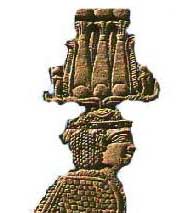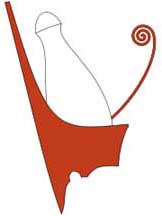
Click on illustration for larger size
| Amen /Amun/ Amon/ Amen-Re/ Amon-Ra/ Amon-Re Alternate spellings: Amen /Amun/ Amon Alternate spellings: Re/ Ra Alternate spellings: Amen-Re/ Amen-Ra/ Amun-Re/ Amun-Ra/ Amon-Re/ Amon-Ra Amun (pronounced AM mun) Amun did not physically engender the universe. His position as King of gods developed to the point of virtual monotheism where other gods became manifestations of him. With Osiris, Amun-Ra is the most widely recorded of the Egyptian gods. Amun became depicted in human form, seated on a throne, wearing on his head a plain, deep circlet from which rise two straight parallel ostrich plumes, but it can also be worn by a king. It appears to associate the ruler with Amun and to legitimate his rule under the god's protection. The plumes were symbolic of the spirit of duality. The Amun crown can be adorned with horns, disks and uraei. Chief consort was Mut.
The Temple Complex at Karank honors him. The word Amen in Christianity is not derived from the Egyptian god.
| ||||||||||||||||
| . | ||||||||||||||||
Animals Cat-headed - Bastel James Stevens Curl: "... the ancient Egyptians seem to have regarded animals as possessing the archetypal qualities of their deities (e.g. bull = power and regeneration; cow = mother; and ram = sexual power and fecundity ... the reverence shown to animals at certain cult-centres did not mean that the creatures themselves were worshipped: what was important was what the animals represented. The main cult centres were as follows:
| ||||||||||||||||
| . | ||||||||||||||||
AKA ansate cross, crux ansata ("handle-shaped cross")Ancient Egyptian hieroglyph - a cross shaped like a T with a loop at the top. Symbol of eternal life, It is found in ancient tomb inscriptions, including those of the King Tutankhamen. Egyptian gods are often portrayed carrying it by its loop, or bearing one in each hand, arms crossed over their chest. Ra is usually represented with the body of a man and the head of a hawk, holding an ankh & scepter. In ancient Egypt, only kings, queens and gods were allowed to carry the ankh, indicating that only the king or god holding it had the power to give life or take it away from lesser mortals. Possible origins:
| ||||||||||||||||
| . | ||||||||||||||||
| Anubis (a NOOB is) Jackel-headed god of embalming (responsible for embalming) Son of Osiris and Isis His head is black. Jackals used to haunt cemeteries, so they were linked with funerals - the idea being that a jackal god would protect the domain of the dead. | ||||||||||||||||
| . | ||||||||||||||||
Apedemak
In Nubian mythology, Isis was his wife.
| ||||||||||||||||
| Beard From the Old Kingdom onward, the king often wears a long, square-ended artificial (or false) beard, fastened by a strap along the jawbone. Gods wear curved beards Kings wear straight beards | ||||||||||||||||
| . | ||||||||||||||||
| Crook and flail Scepters Most commonly represented together, held across the chest of the kings, Osiris identified with them. See illustration on The Virtual Egyptian Museum | ||||||||||||||||
| . | ||||||||||||||||
Crowns/Headdresses
| ||||||||||||||||
| . | ||||||||||||||||
| Eye of Horus / Wedjat / Wadjet / Eye of Ra /
Eye of the Moon / Udjat An ancient Egyptian symbol of protection and royal power from deities, in this case from Horus or Ra. The symbol is seen on images of Horus' mother, Isis, and on other deities associated with her. In the Egyptian language, the word for this symbol was "Wedjat," a solar deity and this symbol began as her eye, an all seeing eye. The Wedjat "was intended to protect the king in the afterlife" and to ward off evil. The Eyes of Horus: Horus fought with Seth (his uncle) for the throne of Egypt. In this battle one of his eyes was injured and later it was healed by Isis (his mother). His right eye represented the sun; his left eye the moon. In early artwork, Hathor is also depicted with this eye. Funerary amulets were often made in the shape of the Eye of Horus. Ancient Egyptian and Near Eastern sailors would frequently paint the symbol on the bow of their vessel to ensure safe sea travel. | ||||||||||||||||
| . | ||||||||||||||||
 Griffin: Head and wings of an eagle
and the body of a lion. Griffin: Head and wings of an eagle
and the body of a lion.The griffin was known in Egypt before 3300 BC and is possibly more ancient still. Emanated protective power. Middle Ages: Griffins not only mated for life, but also, if either partner died, then the other would continue throughout the rest of its life alone, never to search for a new mate. The griffin was thus made an emblem of the Catholic Church's views on remarriage.
| ||||||||||||||||
| . | ||||||||||||||||
 Hathor (HATH er) Hathor (HATH er)Hathor is commonly depicted as a cow goddess with head horns in which is set a sun disk with Uraeus. Hathor is at times the mother, daughter and wife of Ra and, like Isis, is at times described as the mother of Horus Depicted as "Mistress of the West" welcoming the dead into the next life. The Ancient Greeks identified Hathor with the goddess Aphrodite and the Romans as Venus. For more information, see Wikipedia: HathorThe Smaller Temple at Abu Simbel was dedicated to Hathor.
| ||||||||||||||||
| . | ||||||||||||||||
 Horus (HOR us)God of the sky,
depicted as a falcon, or as a hawk/falcon-headed man. Horus (HOR us)God of the sky,
depicted as a falcon, or as a hawk/falcon-headed man.Since Horus was said to be the sky, he was considered to also contain the sun and moon. It became said that the sun was his right eye and the moon his left, and that they traversed the sky when he, a falcon, flew across it. Thus he became known as Harmerty - Horus of two eyes. Myth of Osiris, Isis and Horus: Osiris was a king who taught the Egyptians how to live, worship and grow corn. He was murdered by his jealous brother, Seth, who cut up the body, scattering it over Egypt. Osiris's beloved wife, Isis, and her sister collected all the pieces. Isis used her medical skills first to impregnate herself with the last drop of semen in her consort's penis, and then to reassemble the corpse as the first mummy and bring it back to life. The first magic worked, and she became pregnant with Horus. But the gods refused to let Osiris return to the world of mortals, and he went to rule in the Underworld, the lord and judge of the dead. Myth of Horus and Seth: Horus would avenge his father at Edfu and Horus became known as the Egyptian god of the sky. In that Horus was the son of Osiris, he became closely associated with the Pharaoh of Lower Egypt (where Horus was worshipped), and became their patron. Seth was the patron of Upper Egypt. Horus united Egypt and bestowed divinity upon the pharaohs who were viewed as incarnations of Horus in life. On the other hand, , once the two lands were united, Seth and Horus were often shown together crowning the new pharaohs, as a symbol of their power over both Lower and Upper Egypt. For a detailed account, see The Sacred Temple Island of Philae: The Great Quarrel Later Egyptians interpreted the myth of the conflict between Set and Osiris/Horus as an analogy for the struggle between the desert (represented by Seth) and the fertilizing floods of the Nile (Osiris/Horus). The Eyes of Horus: Horus fought with Seth (his uncle) for the throne of Egypt. In this battle one of his eyes was injured and later it was healed by Isis (his mother). His right eye represented the sun; his left eye the moon. Forms of Horus: Mythologically, the god was imagined as a celestial falcon, whose right eye was the sun and left eye the moon. The speckled feathers of his breast were probably considered to be the stars, while his wings were the sky that created the wind. The most familiar form of Horus is as a full falcon, probably the lanner (Falco biarmicus) or peregrine (Falco peregrinus). It is as a falcon-headed man that the god most frequently appears, often wearing one the following crowns: Double Crown (Pschent) signifying his kingship over all Egypt.Horus is also depicted with wings in a solar disk flanked by 2 cobras and vulture with outspread wings See also: Jimmy Dunn, Horus, The God of Kings See also illustration on The Virtual Egyptian Museum | ||||||||||||||||
| . | ||||||||||||||||
 Isis (EYE
sis) Isis (EYE
sis)The principal goddess worshiped by the Egyptians. She was regarded as the mother of Horus, the sister and wife of Osiris, and the sister of Set and Nebthet. The Egyptians adored her as the goddess of fecundity, and as the great benefactress of their country, who instructed their ancestors in the art of agriculture. Isis, Osiris and Horus are sometimes referred to as a "trinity." "Her cult continued to grow in importance until it ultimately absorbed that of nearly all the other goddesses. ... It was not until the middle of the sixth century, in the reign of Justinian, that the temple of Philae - her chief sanctuary in the extreme south of the country - was closed to her cult and turned into a church." - New Larousse Encyclopedia of Mythology, Prometheus Press, 1972 edition, p.19 Myth of Osiris Isis and Horus: Osiris was a king who taught the Egyptians how to live, worship and grow corn. He was murdered by his jealous brother, Seth, who cut up the body, scattering it over Egypt. Osiris's beloved wife, Isis, and her sister collected all the pieces. Isis used her medical skills first to impregnate herself with the last drop of semen in her consort's penis, and then to reassemble the corpse as the first mummy and bring it back to life. The first magic worked, and she became pregnant with Horus. But the gods refused to let Osiris return to the world of mortals, and he went to rule in the Underworld, the lord and judge of the dead. Isis became known as the Egyptian goddess of the children. Horus would avenge his father and Horus became known as the Egyptian god of the sky. In that Horus was the son of Osiris, he became closely associated with the Pharaoh of Lower Egypt (where Horus was worshipped), and became their patron. Set(h) was the patron of Upper Egypt. Horus united Egypt and bestowed divinity upon the pharaohs who were viewed as incarnations of Horus in life. The Temple at Dendur and the Temple at Philae were dedicated to Isis.
| ||||||||||||||||
| . | ||||||||||||||||
| Lotus | ||||||||||||||||
| . | ||||||||||||||||
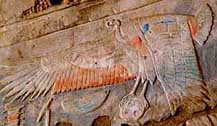 Nekhbet (Nechbet,
Nekhebit), Vulture GoddessPatron of
Upper Egypt Nekhbet (Nechbet,
Nekhebit), Vulture GoddessPatron of
Upper EgyptDepicted as the Egyptian white vulture: Depicted as the Egyptian white vulture - the griffon vulture (Gyps fulvus). The priestesses of Nekhbet wore robes of vulture feathers.Depicted as one of the twin Uraei: From the 18th Dynasty onwards, she began to be represented as protecting the royal women in the form of one of the twin Uraei (spitting cobras) on the headdresses of the queensDepicted as woman wearing the Atef-crown See illustration on Echoes: The Egyptian Vulture Goddess NekhbetSee also: Horus who is depicted with wings in a solar disk flanked by 2 cobras and vulture with outspread wings See Wikipedia: Nekhbet
| ||||||||||||||||
| . | ||||||||||||||||
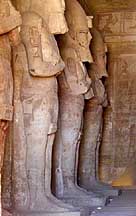 Osiris (oh SIRE
is) Osiris (oh SIRE
is)God of the Underworld. Osiris was usually depicted as a green-skinned (green was the color of rebirth) pharaoh wearing the Atef crown , a crown worn by the god Osiris, and by the king. It is composed of a central miter mounted upon two ram's horns, surmounted by a sun disk and flanked by two ostrich feathers. Typically he was also depicted holding the crook and flail which signified divine authority in Egyptian pharaohs and his feet and lower body were wrapped, as though already partly mummified. Myth of Osiris Isis and Horus: Osiris was a king who taught the Egyptians how to live, worship and grow corn. He was murdered by his jealous brother, Seth, who cut up the body, scattering it over Egypt. Osiris's beloved wife, Isis, and her sister collected all the pieces. Isis used her medical skills first to impregnate herself with the last drop of semen in her consort's penis, and then to reassemble the corpse as the first mummy and bring it back to life. The first magic worked, and she became pregnant with Horus. But the gods refused to let Osiris return to the world of mortals, and he went to rule in the Underworld, the lord and judge of the dead. Isis became known as the Egyptian goddess of the children. Horus would avenge his father and Horus became known as the Egyptian god of the sky. In that Horus was the son of Osiris, he became closely associated with the Pharaoh of Lower Egypt (where Horus was worshipped), and became their patron. Set(h) was the patron of Upper Egypt. Horus united Egypt and bestowed divinity upon the pharaohs who were viewed as incarnations of Horus in life.In the Serapeum at Saqqara, archaeologists found the mummies of one and a half million ibises and hundreds of thousands of falcons.
| ||||||||||||||||
| . | ||||||||||||||||
Long, thin shaft surmounted by a triangular umbel Papyrus | ||||||||||||||||
| . | ||||||||||||||||
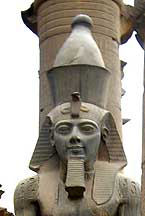 Pharaoh Pharaoh"Pharaoh is a title used in many modern discussions of the ancient Egyptian rulers of all periods. In antiquity this title began to be used for the ruler who was the religious and political leader of united ancient Egypt. This was true only during the New Kingdom, specifically during the middle of the eighteenth dynasty. For simplification however, there is a general acceptance amongst modern writers to use the term to relate to all periods." - Wikipedia: Pharaoh The pharaoh, or king of Egypt, was viewed as both human and divine, and thus acted as intermediary between Egypt's people and the gods. The king was also associated with several specific deities. While alive, a pharaoh was identified with Horus, and given the title "Son of Ra." The goddesses Isis, Hathor, and Mut were all seen as the mother of the pharaoh. A deceased king was viewed as fully divine, and identified with Osiris (the father of Horus) and with Ra. A common depiction of the king is his holding a group of enemies of Egypt by the hair and raising his club to smite them. Crowns / Nemes Ptolemaic dynasty The pharaoh often was depicted as wearing a false beard made of goat hair during rituals and ceremonies
| ||||||||||||||||
| . | ||||||||||||||||
| Ram's horns | ||||||||||||||||
| . | ||||||||||||||||
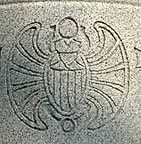 Scarab / dung
beetle Scarab / dung
beetleDung beetles are beetles that feed partly or exclusively on feces. Many dung beetles, known as rollers, are noted for rolling dung into spherical balls, which are used as a food source or brooding chambers. Scarab dung beetles lay eggs in a pellet which they roll along and the Egyptians regarded this action as an image of the sun and its course through the heavens, rolled by a gigantic beetle. Scarabs are associated with the Egyptian god, Khepri. It was Khepri that pushed the sun across the sky. The scarab beetle became an ancient Egyptian symbol for rebirth, the ability to be reborn. Each day the sun disappeared, always to rise again and be reborn the following day. The god Khepri, which literally means "He who is Coming into Being", was a creator god and a solar deity. He was represented as a scarab or dung beetle, or as a man with a beetle head. Often represented as a beetle within the sun-disk. The scarab beetle was observed to roll its eggs in a ball of dung along the ground, and the ball was identified with the sun. The baby beetles were seen to emerge from the primeval mound and so dung beetles were thought capable of spontaneous creation. Hence, the scarab became an important symbol of creation, resurrection and everlasting life in the religious mythology of ancient Egypt. Alternate myth: Isis Small jars and coffins containing dried (mummified) scarabs were often placed in Egyptian tombs as part of their ancient funeral rites to ensure eternal resurrection. Winged scarab / heart scarab: So-called heart scarabs, usually flanked with falcon's wings, were funerary talismans. The stone heart scarab was laid upon the breast of the mummy, and this indicated that the guilty soul must stand in the judgment hall in the presence of Osiris. The scarab thus used was to secure exemption from the possible performance of an evil life. Perhaps the most famous example of such "heart scarabs" is the yellow-green pectoral scarab found among the entombed provisions of Tutankhamen. Ra was also pictured as scarab that has the body of a scarab with outstretched falcon wings, scarab forelegs, and falcon back legs.
| ||||||||||||||||
| . | ||||||||||||||||
| Scepter A rod or wand borne in the hand as an emblem of regal or imperial power. The hieroglyph for "nobleman" or "official" shows a man carrying a long staff of office in front of him. See alsoAncient Egypt Online: mks, Heqa, Was, Flail See also: Toby A. H. Wilkinson, Early Dynastic Egypt: mks, Heqa, Was, Flail See also: Toby A. H. Wilkinson, Early Dynastic Egypt: Mace and long staff See also: Wiklipedia: Sekmen scepter
| ||||||||||||||||
| . | ||||||||||||||||
 Sekhmet, Sachmet,
Sakhet, Sekmet, Sakhmet and Sekhet Sekhmet, Sachmet,
Sakhet, Sekmet, Sakhmet and SekhetAppearance: Woman with the head of a lioness. She was envisioned as a fierce lioness, and in art, was depicted as such, or as a woman with the head of a lioness, who was dressed in red, the colour of blood. Sekhmet was the goddess of war. For more information, see Wikipedia: Sekhmet See also a poem by Margaret Atwood, Sekhmet, the Lion-headed Goddess of War
| ||||||||||||||||
| . | ||||||||||||||||
| Set(h)Osiris was a king who taught the Egyptians how to live, worship and grow
corn. He was murdered by his jealous brother, Seth, who cut up the body, scattering it
over Egypt. Osiris's beloved wife, Isis, and her sister collected all the pieces. Isis used her medical
skills first to impregnate herself with the last drop of semen in her consort's
penis, and then to reassemble the corpse as the first mummy and bring it
back to life. The first magic worked, and she became pregnant with Horus. Seth and his followers changed themselves into crocodiles to escape Horus. The ancient Egyptians believed that by honoring the fearsome crocodile as a god, they would be safe from attacks. Horus would avenge his father at Edfu and Horus became known as the Egyptian god of the sky. In that Horus was the son of Osiris, he became closely associated with the Pharaoh of Lower Egypt (where Horus was worshipped), and became their patron. Seth was the patron of Upper Egypt. Horus united Egypt and bestowed divinity upon the pharaohs who were viewed as incarnations of Horus in life. On the other hand, once the two lands were united, Seth and Horus were often shown together crowning the new pharaohs, as a symbol of their power over both Lower and Upper Egypt. For a detailed account, see The Sacred Temple Island of Philae: The Great Quarrel | ||||||||||||||||
| . | ||||||||||||||||
|
Solar (Sun) disk flanked by 2 cobras and outspread
wings: Solar disk represents Ra, the sun god. Cobras represent the Uraeuses (Wadjet and Nekhbet) Wings: Vulture wings represent Nekhbet - OR Falcon wings represent Horus A symbol of protection. Often occurring on a cavetto cornice. The Winged Sun Disc is thought to have originated from the corona effect of a solar eclipse which can give the appearance of wings.
| ||||||||||||||||
| . | ||||||||||||||||
 Sun god Sun godOverall, the sun god was the dominant deity in Egyptian religion, although he could take different forms.. The earliest deities associated with the sun are Wadjet, Sekhmet, Hathor, Nut, Bast, Bat, and Menhit. First Hathor, and then Isis, give birth to and nurse Horus and Ra. In the eighteenth dynasty, Akhenaten changed the polytheistic religion of Egypt to a pseudo-monotheistic one, Atenism. All other deities were replaced by the Aten, including, Amun, the reigning sun god of Akhenaten's own region. Unlike other deities, the Aten did not have multiple forms. His only image was a disk - a symbol of the sun. Most common forms:"Re" is an alternate form of "Ra." Sun boat: Ra was thought to travel in a sun boat (The Boat of the Millions) to protect its fires from the primordial waters of the underworld it passed through during the night. Ra traveled in the sun boat with various other deities including Set and Mehen who defended against the monsters of the underworld, and Ma'at who guided the boat's course. The monsters included Apep, an enormous serpent who tried to stop the sun boat's journey every night by consuming it. The Ra myth saw the sunrise as the rebirth of the sun by the goddess Nut and the sky, thus attributing the concept of rebirth and renewal to Ra and strengthening his role as a creator god. Alternate myth: See "Scarab " below. The benu bird is Ra's bird and a symbol of fire and rebirth (see Obelisk). | ||||||||||||||||
| . | ||||||||||||||||
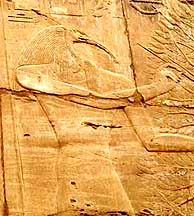 Thoth (TOTE) Thoth (TOTE)Ibis-headed (sometimes, however, a baboon) god of wisdom. The Sacred Ibis (Threskiornis aethiopicus) is now extinct. The curved beak of the ibis was like the crescent moon, so the bird became the symbol of the moon god Thoth. The ancient Egyptians believed that Thoth gave them the gift of hieroglyphic writing. At the town of Hermopolis, ibises were reared specifically for sacrificial purposes and in the Serapeum at Saqqara, archaeologists found the mummies of one and a half million ibises and hundreds of thousands of falcons. | ||||||||||||||||
| . | ||||||||||||||||
 Uraeus (you REE us) (plural: Uraei or Uraeuses) Wadjet (spitting cobra) and Sun disk.
Nekhbet, vulture wings added
later. Uraeus (you REE us) (plural: Uraei or Uraeuses) Wadjet (spitting cobra) and Sun disk.
Nekhbet, vulture wings added
later.Spitting cobra: The Uraeus is the stylized, upright form of an Egyptian spitting cobra used as a symbol of sovereignty, royalty, deity, and divine authority in ancient Egypt.Spitting cobra plus white vulture: At the time of the unification of Egypt, the image of Nekhbet, who was represented as a white vulture and held the same position as the patron of Upper Egypt, joined the image of Wadjet on the Uraeus that would encircle the crown of the pharaohs who ruled the unified Egypt. Together they were known as, The Two Ladies, who became the joint protectors and patrons of the unified Egypt.Worn by the Pharaoh as a golden emblem on the forehead as a sort of crown; it was the symbol of supreme rulers, and a symbol of Pharaoh's power.Beside the Uraeus being used as an ornament for statuary or as an adornment on the pharaoh, it also was used for jewelry and in amulets. However another important use is as the hieroglyph.In that the Uraeus was seen as a royal symbol, Horus and Set also were depicted wearing one.
| ||||||||||||||||
| . | ||||||||||||||||
| Wadjet / Wadjit /
Wedjet / Uadjet / Ua Zit Cobra goddess; Patron of Lower Egypt. AKA The Green One Depicted as a cobra in the Uraeus. After unification of Egypt, joined by her sister Nekhbet with the wings of a vulture in the Uraeus. She came to be the patron and protector of Lower Egypt, and upon unification with Upper Egypt, the joint protector and patron of all of Egypt with the goddess of Upper Egypt (Nekhbet). The Two Ladies: The vulture-goddess Nekhbet and the cobra-goddess Wadjet, representing the Upper Egypt and Lower Egypt respectively. See above: Uraeus and Eye of Horus | ||||||||||||||||
| . | ||||||||||||||||
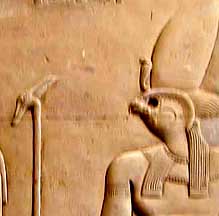 Was-scepter Was-scepterStood for domination and power. It was very common among gods/kings in all times. Sometimes depicted as a stylized animal head on top and a forked end. A staff made from a dried bull's penis that was the symbol for the goddess Wosret or Wasret. Also used to hold up roofs. See also on another website: 9 illustrations
| ||||||||||||||||
| . | ||||||||||||||||
| Wings
Horus Isis Nekhbet Re-Harakhty Scarab |




